Views From the Boardwalk
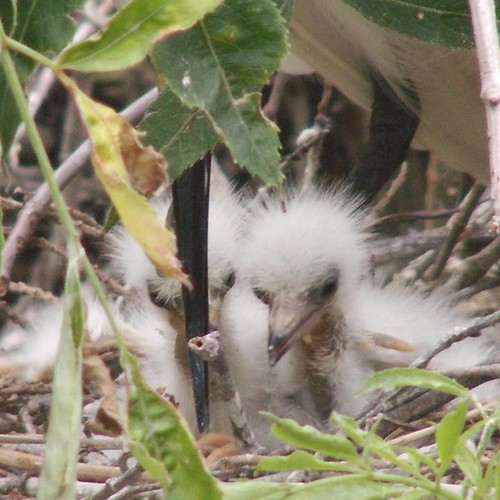
At first I didn't know what species these hatchlings were, but then I noticed that the black shape before the left hatchling's face is a beak belonging to an adult Snowy Egret.
More photos and video from the rookery at the St. Augustine Alligator Farm and Zoological Park....
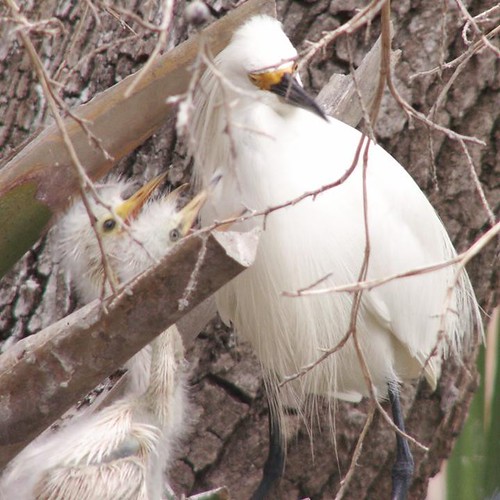
According to the University of Michigan Museum of Zoology, the Snowy Egret (Egretta thula, Family Ardeidae) "is a partially migratory species, as it relocates from its northern habitats of the United States and Canada to its winter ranges located in Mexico, Central America, South America, the West Indies, and Bermuda. Snowy Egrets begin their northward migration in early March and depart in September to migrate to their wintering areas."
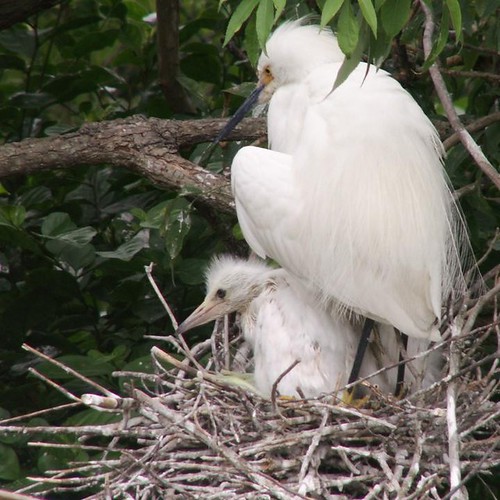
My first St. Augustine entry has another shot of a Snowy Egret with young.
According to UMMZ, Snowy Egret nests "are composed of woven twigs and small sticks that female egrets collect from the ground or steal from other nests. Egretta thula may also reuse old nests. These egrets are highly social nesters and build nests close to other egrets or herons....Females lay 3-6 eggs at a time (on average); eggs have a pale, greenish blue color. Incubation lasts 24 days on average and the chicks usually fledge 14 days after hatching. Young reach reproductive maturity after 1 to 2 years."
I was relieved to read that the parents remove the eggshells from the nest after hatching occurs. We had seen a cracked egg meeting the above description on the ground and feared the worst, especially given this fallen hatchling:
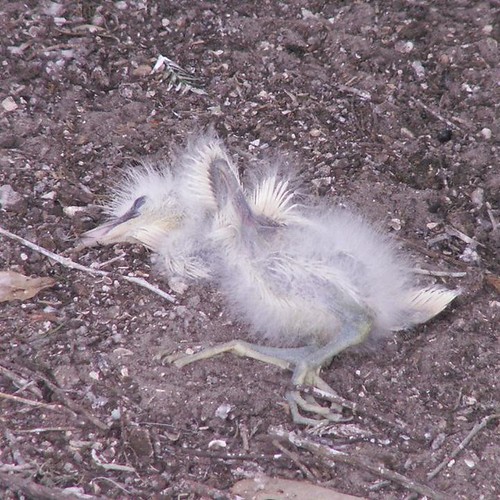
I was photographing several feet away when Mary had seen this chick "plop to the ground" from a nest above. It had flopped once and then lay still. The two hatchlings remaining in the nest stared intently at the corpse. An adult landed briefly a few feet away, then returned to the branches.
A small alligator drew slowly closer to land. Mary theorizes the gator didn't want to draw attention to itself and this bit of food. In addition to protecting the birds from predators, the alligators also serve as a kind of clean-up crew.
Two days later I was drinking coffee at our hotel when a small sparrow slammed head-first into the plate-glass window by the breakfast table. My heart sank that a second bird might be dead before my eyes so quickly after the first. But after flopping about and sitting still, stunned, the sparrow righted itself and flew away as I opened the door, bagel in hand in case it needed food.
A manager at the hotel who visits the rookery frequently told us that the weakest nestlings are refused nourishment, which then goes to stronger siblings.
A trio of hatchlings looking much like the Snowies up top vie for position in Down In Front!
A pair of young Snowies (positively identified due to the parent standing above them) compete for attention in Sibling Rivalry. I had held my camera on end, so this movie is rotated 90 degrees from where I want it to be. I don't yet have movie editing software to set it right, but still thought it entertaining enough to post. (Mary: "If you can't get the parent's attention, then chomp on your sibling's bill, that's it!")
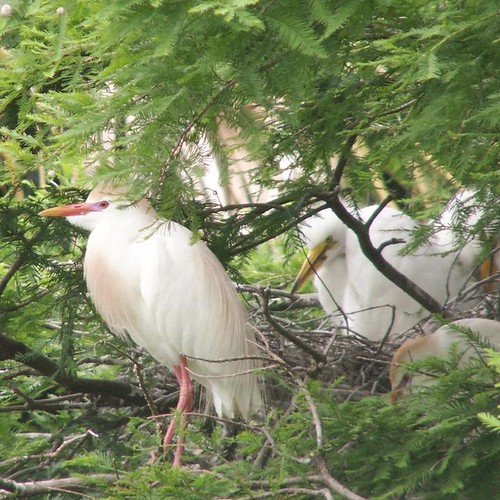
I had seen cattle egrets (Bubulcus ibis) in our neighborhood, but this was the first time I had seen one in breeding coloration. Outside of breeding season, this cattle egret would have dark legs. The yellowish feathers on top of her head and back and on her chest also indicates that she is breeding.
Says eNature.com: "Originating in the Old World, the Cattle Egret crossed the Atlantic, probably flying from Africa to South America, where this species was first reported in the late 19th and early 20th centuries. The birds gradually spread northward through the West Indies and into Florida, then northward and westward. As in the Old World, Cattle Egrets in North America follow large grazing animals to feed on the insects they disturb and can often be seen perched on the backs of livestock. At some airports, especially those near salt marshes, these small herons wait at the edge of runways for passing airplanes to blow insects out of the grass. Unlike other egrets, this species rarely takes fish, although it is known to capture an occasional frog or toad."
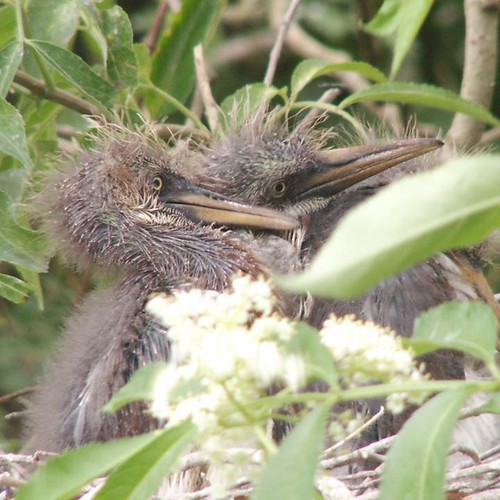
With no parent in this photo, I haven't been able to identify these chicks.
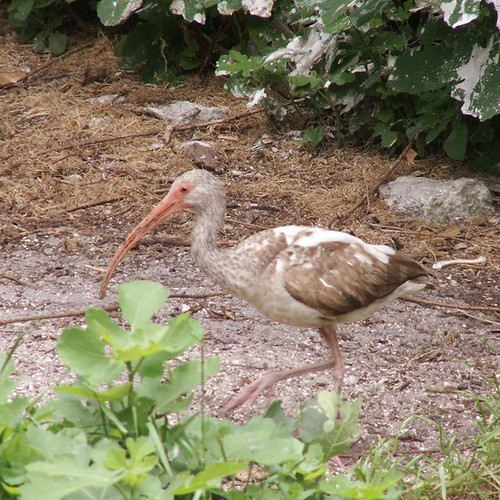
Juvenile White Ibis (Eudocimus albus, Family Threskiornithidae). Says eNature.com, "Around their colonies, ibises eat crabs and crayfish, which in turn devour quantities of fish eggs. By keeping down the numbers of crayfish, the birds help increase fish populations. In addition, their droppings fertilize the water, greatly increasing the growth of plankton, the basic food of all marsh life. White Ibises gather at dusk in spectacular roosts, long lines of birds streaming in from all directions."
The ibis belongs to the same family as the Roseate Spoonbill, which is yet to come -- accompanied by the Tri-colored Heron.
We got the results of Daisy's tests Friday morning, and the news is not good -- but we are fortunate to have learned of it while she is still healthy enough to zip around the house. Daisy has been diagnosed with progressive renal failure. Below, she sits on the notes I took while talking with the vet, and printouts of information I'd downloaded from the Web.
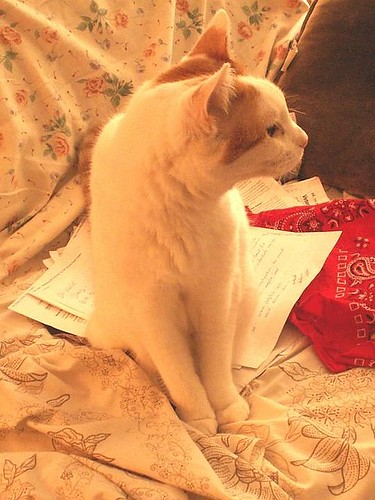
Next week we are starting her on a special renal diet. At this point we don't know how much time she has left in this world (could be years, could be significantly shorter), but we'll try to keep her as comfortable, healthy, and happy as we can while she's still with us. I took a video of her Saturday morning, and will post the link after I've paid a visit to our DSL-enabled library to upload it.











0 Comments:
Post a Comment
<< Home